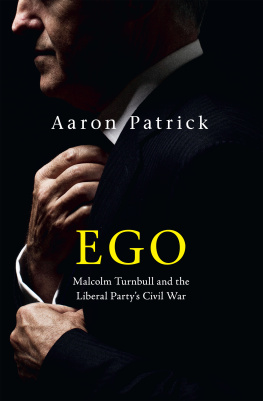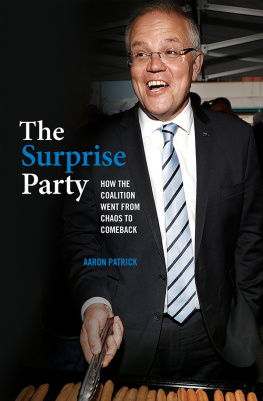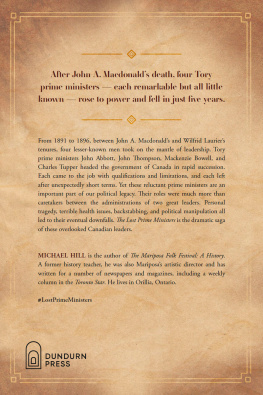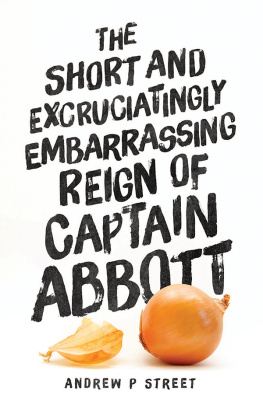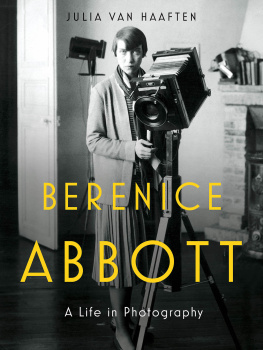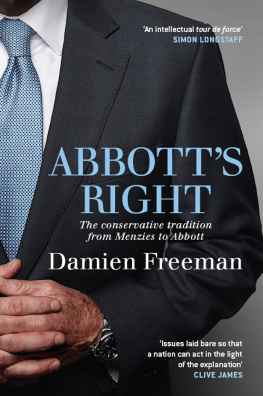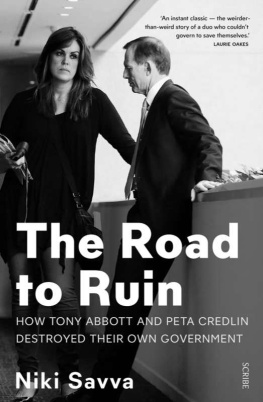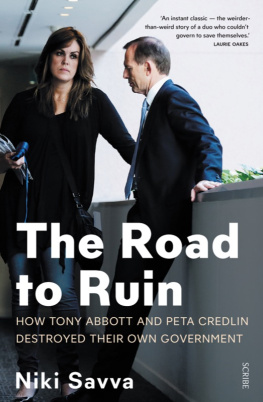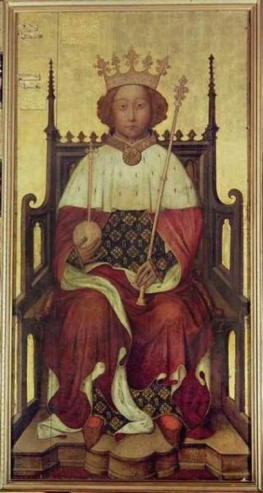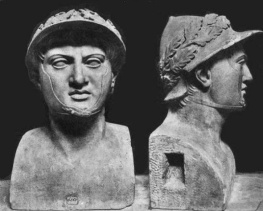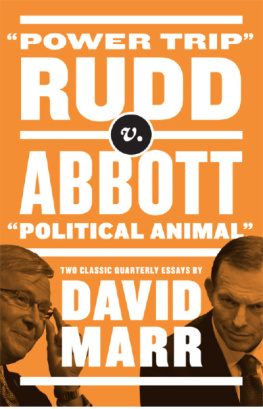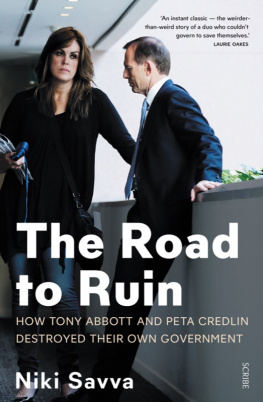Published by Black Inc.,
an imprint of Schwartz Publishing Pty Ltd
Level 1, 221 Drummond Street
Carlton VIC 3053, Australia
www.blackincbooks.com
Copyright Aaron Patrick 2016
Aaron Patrick asserts his right to be known as the author of this work.
ALL RIGHTS RESERVED.
No part of this publication may be reproduced, stored in a retrieval system, or transmitted in any form by any means electronic, mechanical, photocopying, recording or otherwise without the prior consent of the publishers.
National Library of Australia Cataloguing-in-Publication entry:
Patrick, Aaron, author.
Credlin & Co.: how the Abbott government destroyed itself / Aaron Patrick.
9781863958097 (paperback)
9781925203783 (ebook)
Abbott, Tony, 1957. Credlin, Peta. Liberal Party of Australia. PoliticiansAustraliaAttitudes. Politics, PracticalAustralia. Political leadershipAustralia2013. AustraliaPolitics and government2013.
324.29405
Cover design by Peter Long
Text design and typesetting by Tristan Main
To the love of my life,
Kate Bain
PREFACE: THE VICTORY
I n a life packed with success, it was the sweetest moment. The ballroom at Sydneys Four Seasons hotel was full of friends, supporters, admirers, colleagues, supplicants, lobbyists and journalists. Tony, Tony, Tony, many were chanting.
Then he emerged. Anthony John Abbott. Monarchist. Rhodes scholar. Trainee priest. Amateur boxer. Professional pugilist.
Abbott had wanted to run for the leadership of the federal Liberal Party after the humiliating defeat of his mentor, John Howard, at the 2007 election. He had such little support that he didnt bother to stand. When Malcolm Turnbulls leadership imploded in 2009, Abbott stood as a last-minute candidate and was elected by a single vote. Now, he had demolished the man who had been, for a while, the most popular prime minister in Australian history, Kevin Rudd.
On 7 September 2013 Abbott won power for the LiberalNational Coalition, which received 5.9 million votes, 1.6 million more than the shattered Labor Party. Across the country Labors downfall was almost complete: Liberal premiers reigned in every state except South Australia and Tasmania.
At the Four Seasons, Rudds face appeared on the large screens around the ballroom, beamed in by the Coalition channel of choice, Sky News. The audience went still, wondering how Rudd, a master of spin, would explain away the devastating loss, for which he deserved much of the blame. When Rudd boasted that Labor had held most of its Queensland seats, there was silence. The Liberals had expected a landslide; they got a solid win, and Rudd, with typical chutzpah, was rubbing their faces in it.
As he worked his way through a long list of thankyous, a young drunk man yelled out: Does this guy ever shut up? The Liberals couldnt wait for Rudd to finish. Two women mounted the stage with a banner that read Its Tony Time. The chant restarted, drowning out Rudds final words: Tony, Tony, Tony.
When Abbott emerged, hands sprung up from the audience holding mobile phones, capturing the moment on tiny electronic screens. Typically, Abbott was wearing a blue suit, white shirt and blue tie. The government of Australia has changed for just the seventh time, he declared three times to rapturous applause. (He later qualified that it was the seventh time in sixty years.) When Abbott praised his chief of staff, Peta Credlin, the room broke into another chant: Peta, Peta, Peta.
Credlin, who didnt appear to be in the room, was Abbotts aide, adviser, confidante and friend. The daughter of farmers from country Victoria, she was 183 centimetres tall and had long, dark hair, and a taste for stilettos and leopardskin prints.
I thank my personal staff, led by Peta Credlin, who is the smartest and the fiercest political warrior I have ever worked with, Abbott said.
Abbott had made history. Now he could shape it. After the chaos and self-absorption of the Rudd and Gillard governments, Australians wanted calm leadership. They wanted less politics. They wanted a prime minister they could trust and believe in. Was Abbott that guy? His victory speech, watched by millions of Australians, was his chance to define what kind of leader he would be to reveal the kind of a man he was and to start to heal the fissures in Australian politics and civil society that he had done so much to open.
His wife, Margie, a childcare worker born in New Zealand, was by his side. She looked embarrassed, even overwhelmed, by the wave of emotion sweeping up from the floor. The Abbotts three daughters, Frances, Louise and Bridget, stood in a row. Tall, slim and elegant, Frances and Bridget had become regulars on the campaign trail, their faces familiar to millions of Australians. Frances had blanched when her father praised the sex appeal of a Liberal candidate. Louise, secretary to the Australian ambassador to the United Nations in Geneva, had kept a low profile. The presence of the oldest Abbott daughter was a sign, if one were needed, of the importance of the moment to the family. The three daughters represented Australias youthful elite: poised, educated and beautiful. Who wouldnt envy this family?
Something was slightly odd. All three wore entirely white dresses the symbol, in an older age, of virginity. Their mother wore black, the colour of mourning. On the night they became Australias first family, the Abbott women had made a curious fashion statement. What did it mean? Nothing, probably. But it reminded some in the room of Abbotts famous offhand comment in 2010, when he described his daughters virginity as their most precious gift for another person. Abbott was a devoted Catholic and an opponent of abortion. Hed abandoned a career as a priest in part because he knew he would struggle with celibacy.
As the Abbotts soaked up the applause, a young man in an ill-fitting suit joined them on stage. No one seemed to know who he was or what he was doing. He might have been a Liberal volunteer or a family friend. He spoke briefly into the microphone, which was turned off, and stood next to Frances, who gave him a confused look. Then two burly security guards mounted the stage and pulled him away, knocking over an Australian flag.
Fregmonto Stokes was a 25-year-old would-be playwright studying at Sydneys National Institute of Dramatic Art. Adopting an alternative persona Twiggy Palmcock he wanted to embarrass Abbott over his commitment to abolish the mining tax. The guards twisted one of Stokes arms behind his back and marched him out of the room. He was released fifteen minutes later onto the street, where he was abused by strangers who had seen him on television. He gave interviews to TV crews in character, ironically praising the Liberal Partys support for mining.
The security breach sent a shock through the room. The Liberal Party had imposed strict rules about access to the event; even large media organisations had found it difficult to have staff admitted who were not registered. If an activist could get that close to the nations new leader and his family on live television, what did that say about the competence of his organisation?
Stokes and two friends, one carrying a video camera, had brazenly walked in through the Four Seasons main entrance, posing as journalists. They had created yellow wristbands, like those used to identify media representatives, from the wrappers of lollies bought at a convenience store opposite the hotel. Bizarrely, Stokes had a connection to Abbott: his mentor at NIDA was Max Gillies, a pioneer of Australian political comedy and the husband of Abbotts publisher and friend Louise Adler, the chief executive of Melbourne University Press.
Credlins team had failed to keep a student prank from upstaging the greatest night of Abbotts life. Instead, she used her power to humiliate and exclude one of the partys loyal warriors.
Next page

